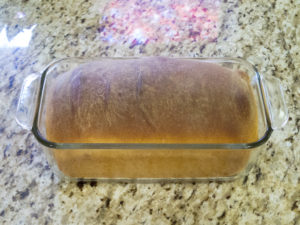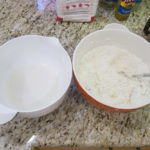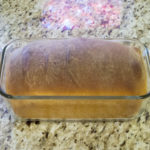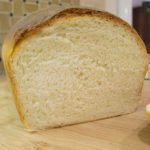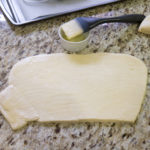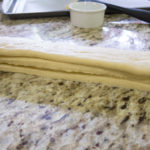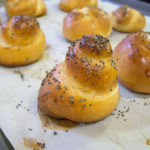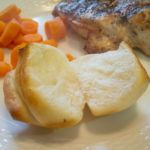Loaf 47 – Enriched Sandwich Bread
All my loaves so far (except Loaf 1 – Beer Batter Bread and Loaf 32 – Irish Soda Breads) have been simple flour + water + yeast + salt + maybe things like grains or nuts or eggs. I haven’t yet made any enriched bread. Enriched breads typically have milk and sugar added to them. In normal life, we refer to enriched breads as ‘sandwich breads’ – like all the loaves we typically buy for PB&Js. I eat a lot of sandwiches, especially during summer lunches at home, and enjoy breads like Milton’s Multi-Grain. I’d like to be able to make a good sandwich bread like that.
My first step is to make a simple white enriched bread and then get more complicated. The recipe I used is from Reinhart’s Artisan Breads Every Day book (p. 105). I divided the dough in two and made a sandwich loaf the first day and dinner rolls the second day.
The dough didn’t rise much in the fridge and was a very different experience to work with in shaping. It is a 55-60% hydration (depending on if you count the egg or not), so it felt more like very soft clay than the wetter doughs I’m used to working with now.
Sandwich Loaf
I baked the loaf in a Pyrex loaf pan rather than the metal one used in the book. I have no idea if that makes a difference. I also cooked it to a darker brown than the picture in the book and didn’t score the top. The resulting crumb and texture look similar to the picture in the book, so I assume I got it pretty close. My bread, however, is yellower from the egg yolk – I’m thinking they may have just used the egg white in the book.
The resulting bread was not as light as I like my sandwich bread to be. It was sweet but too dense. I’m going to try a different recipe for my next sandwich loaf.
The flavor tasted more like a sweet dinner roll, so with the second half of the dough I made…
Dinner Rolls
This was a fun exercise in dough shaping. I made butterflake rolls and a variety of other small shapes.
Butterflake rolls are made by rolling out the dough about 1/4″ thick, painting it with melted butter, slicing it into 2″ strips, stacking and slicing the strips. The resulting stacks are put into cupcake pans to rise.
The other rolls were variations on rolling out snakes and knotting them or rolling them up, and mashing small dough balls together.
The shaped rolls are then proofed for about 2 1/2 hours before baking. During this time they did a very nice rise. Prior to baking they get an egg wash to help browning, and I also sprinkled them with poppy seeds for decoration.
The butterflake rolls were the best of the batch, they divided easily and had a sweet flavor that didn’t demand butter or honey.
Lessons
- I would use this recipe again for butterflake rolls, but will keep searching for my sandwich bread recipe.
- Should have scored the sandwich loaf.
- Milk (left) and flour, yeast, salt, sugar and egg (right)
- Shaped sandwich loaf, post-rise
- Baked loaf
- Internal crumb
- Dough rolled out for butterflake rolls
- Butter, sliced and stacked butterflake rolls
- Shaped rolls, pre-rise
- Shaped rolls after 2 1/2 hour proof
- Baked rolls
- Rolled dough “pops up when ready”
- Butterflake roll with dinner







